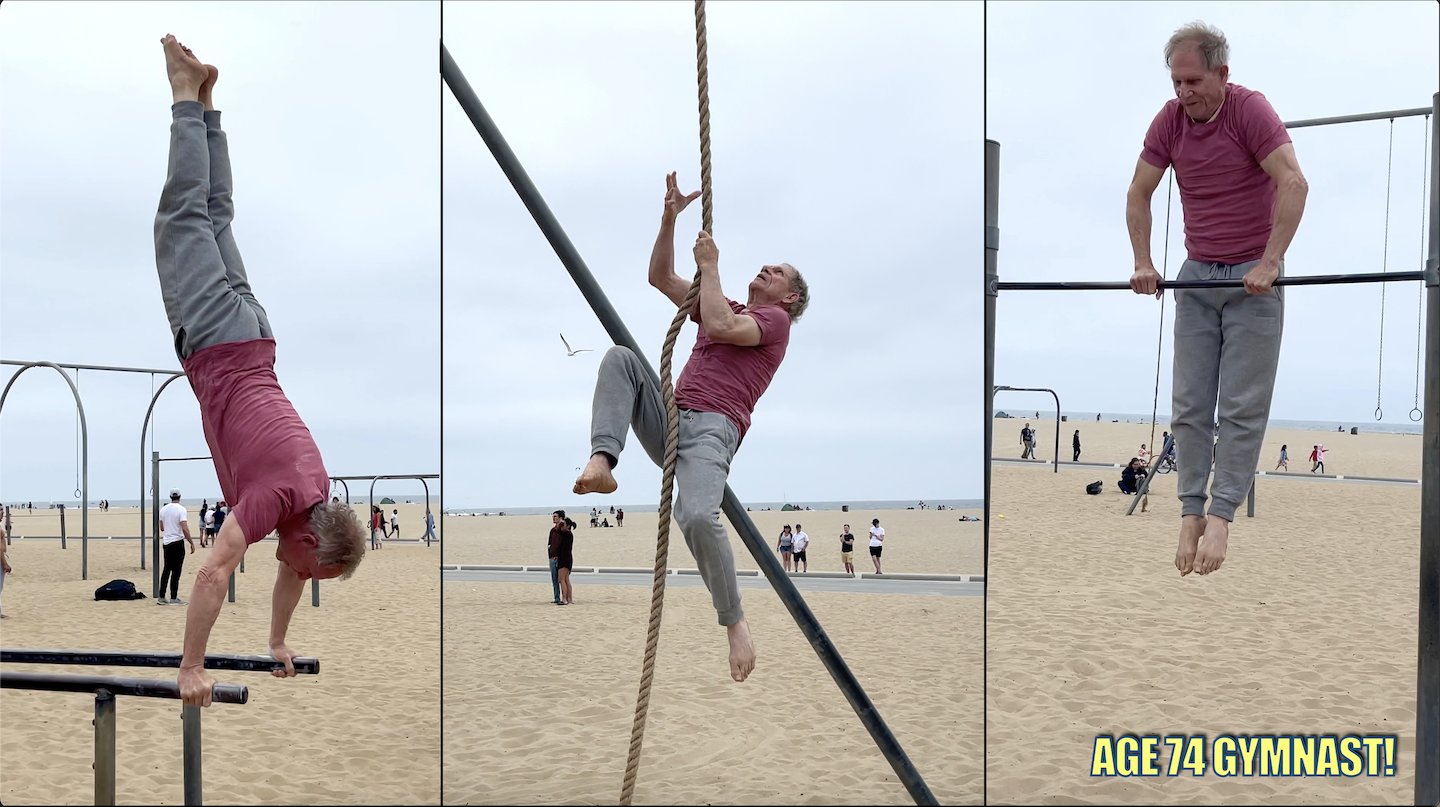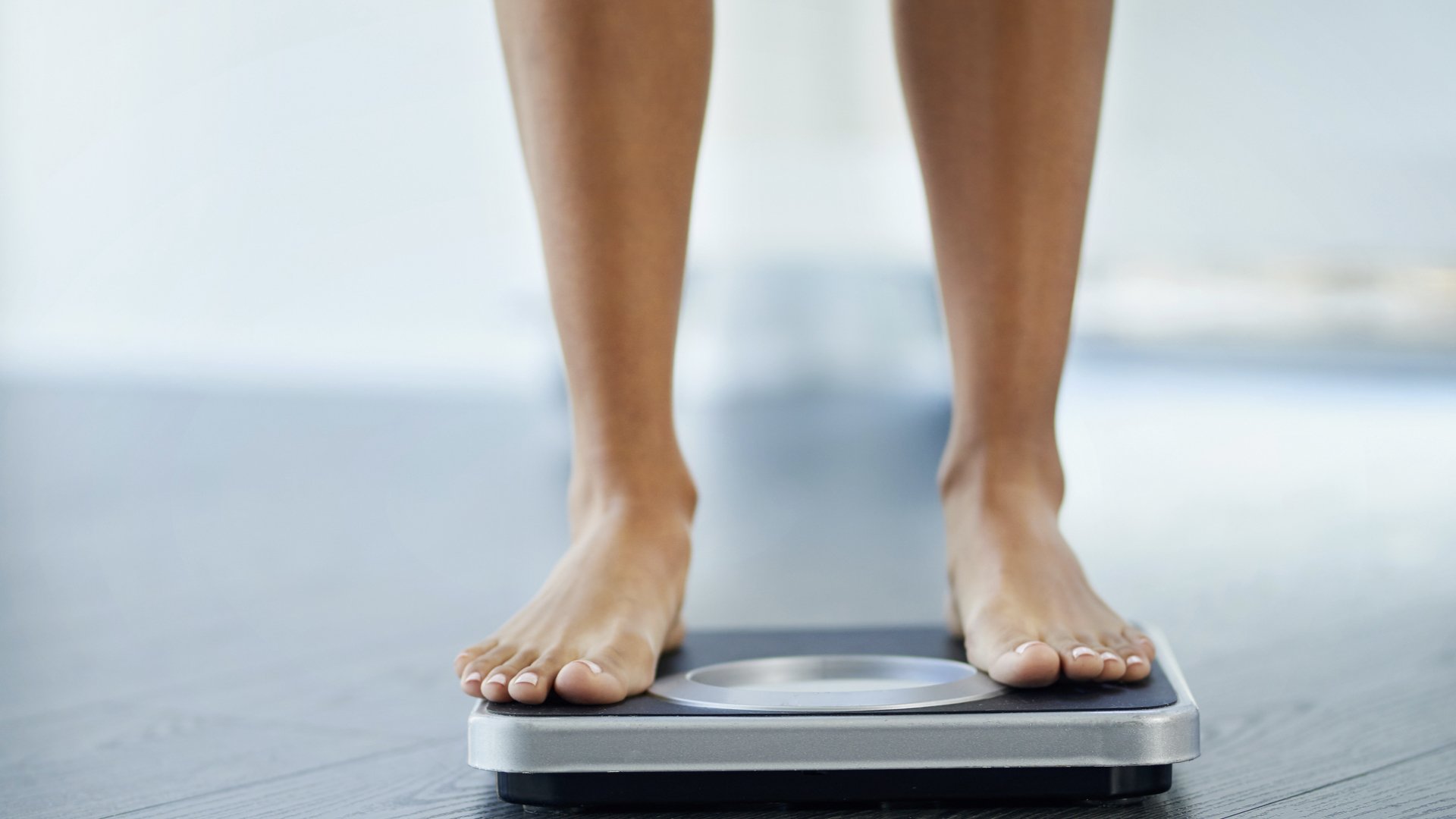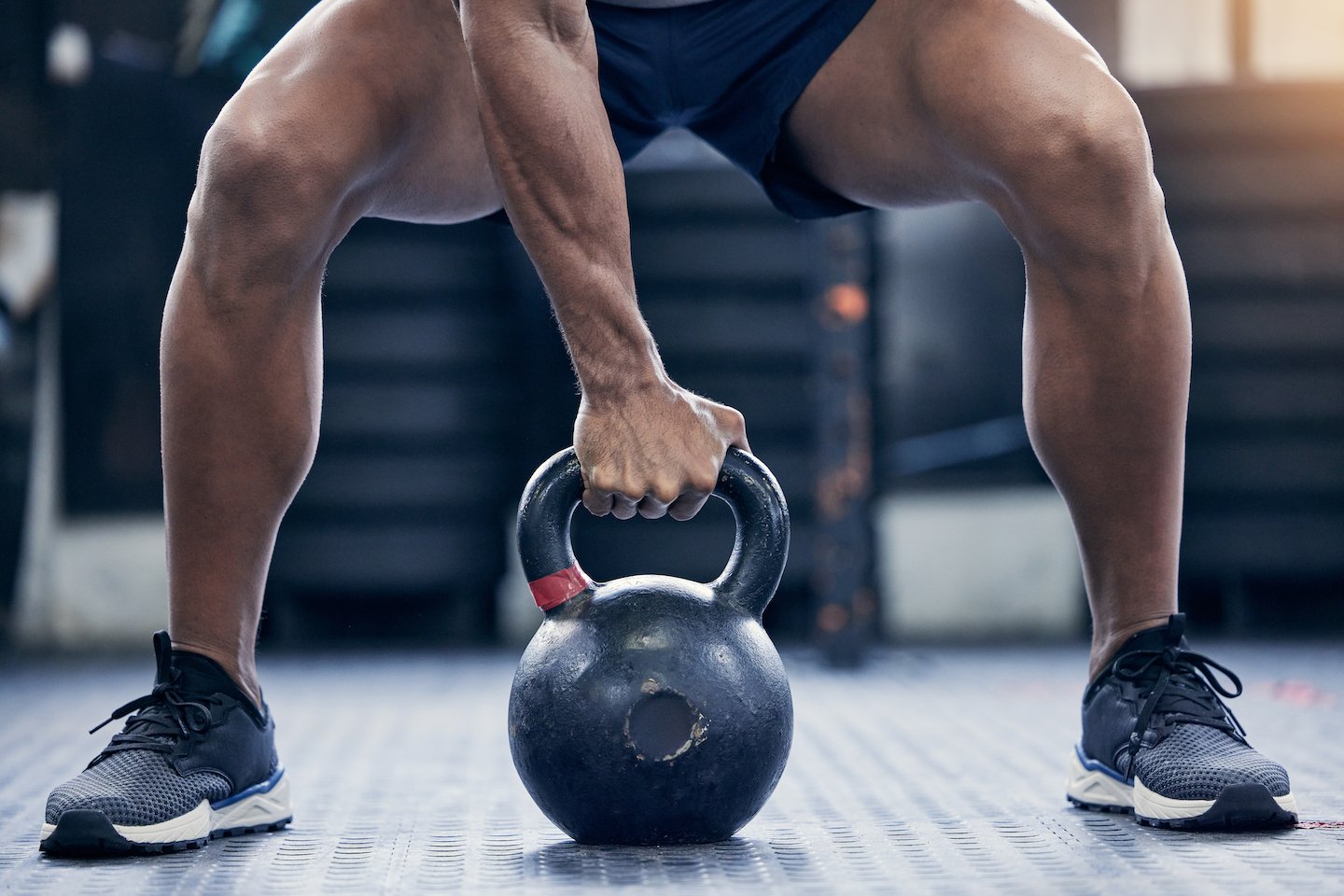
Grip Strength
A proven health indicator. Test and train for lower risks!
Grip strength is an excellent health indicator linked to numerous health outcomes. This simple test may also be the easiest way to estimate your overall strength.
Is average grip strength good enough for long-term health? This masterclass article describes the advantages of training your grip, showing the age-group strength standards you’ll want to match or exceed for better health and well-being.
You’ll also learn to perform a grip strength test correctly with a grip dynamometer and to develop your strength using minimal equipment.
 Test your grip strength to see how your upper body strength can affect your health.
Test your grip strength to see how your upper body strength can affect your health.How is grip strength important for health and longevity?
Studies have revealed that good grip strength is associated with lower risks of cardiovascular disease, depression, cancer, cognitive decline, and premature death. Other benefits include higher quality of life and lower risk of disability in old age (1-9).
There is evidence of accelerated aging, even at a cellular level, with low levels of grip strength (10). For all these reasons, grip strength is like a vital sign. It reflects your current well-being and can predict your future health.
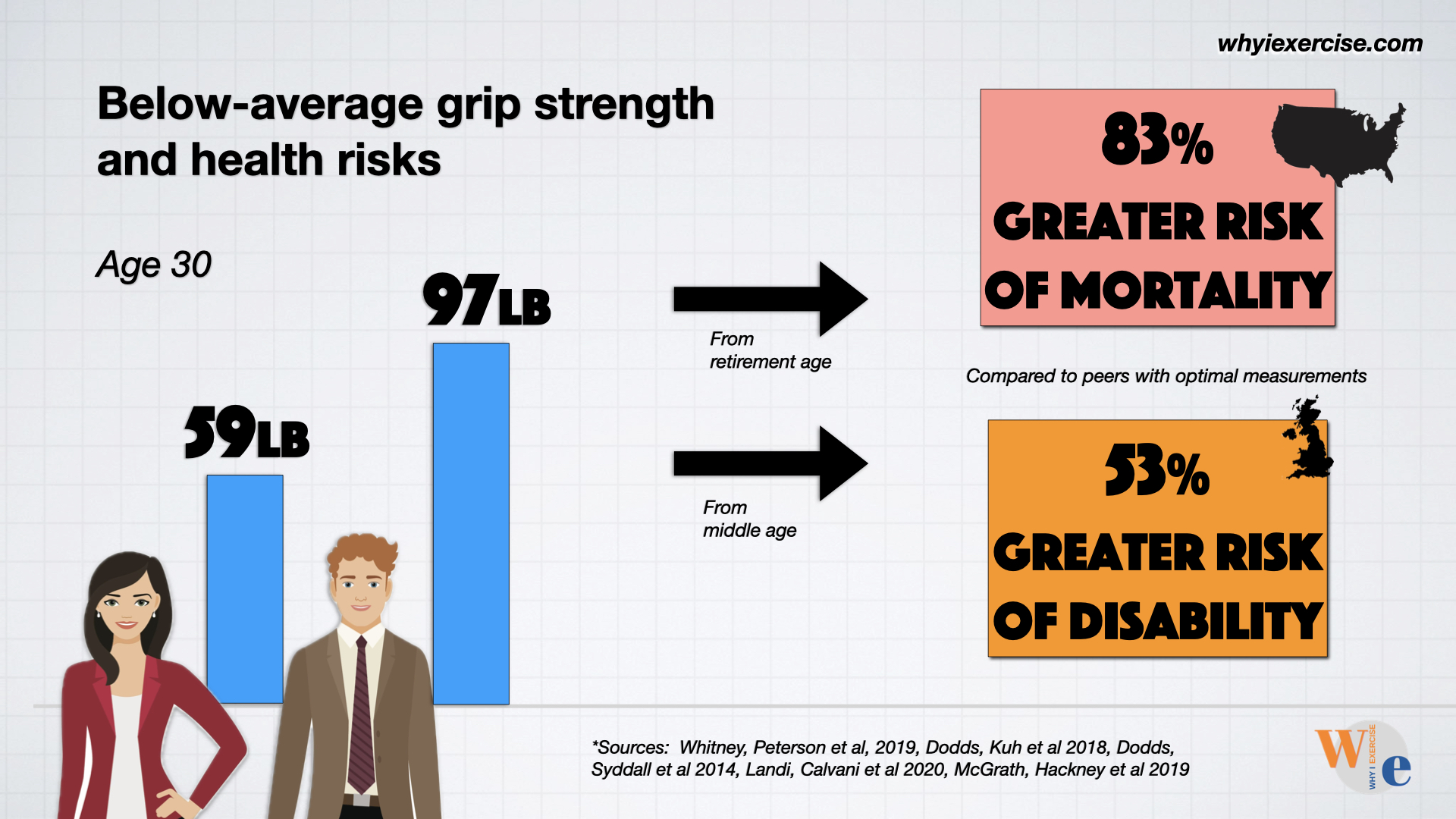 A modest improvement from the grip strength scores above can make a meaningful difference in one's long-term health.
A modest improvement from the grip strength scores above can make a meaningful difference in one's long-term health.When you factor in future loss of strength due to aging, a man with average grip strength (111 lb / 50 kg at age 30) projects to have higher death and disability risks compared to his stronger peers.
The risks can be pronounced for young adults with grip strength just 9-14 pounds below average. They project to have a 53% increased disability risk from middle age and an 83% increased mortality risk by retirement age compared to peers with optimal strength levels (8-9).
This data comes from studies out of the US and the UK.
Increased health risks seem to make the case for strength training, but how can we reliably project disability and mortality? Other studies show how our grip strength declines over time with aging.
We can use an age-based strength curve to help predict health outcomes because if you’re on the blue, green or yellow line in your 30s, you’re likely to be there later in life when studies can best predict death and disability risk (8, 9, 11, 12, 13).
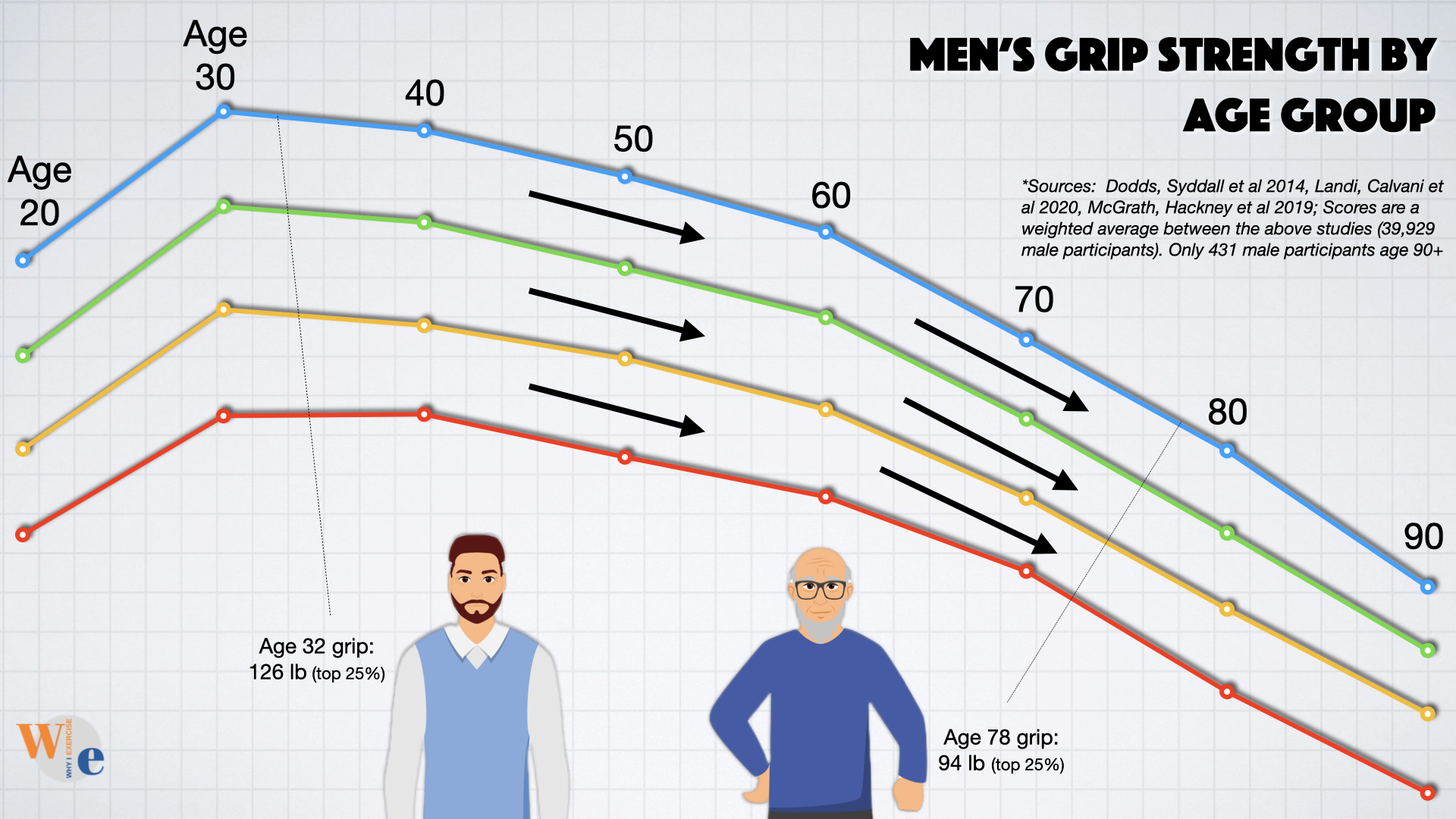 As we age, grip strength declines at about the same rate in people of all ability levels.
As we age, grip strength declines at about the same rate in people of all ability levels.Before we look at the age-group charts below, two other grip strength health standards add to our case for strength training. Cambridge University connected low grip strength with depression and found that working-age women with grip strength above 59.5 lb / 27 kg had the lowest risk of depression.
For men, the standard was 88 lb or 40 kg (15). When you factor in the loss of strength due to aging, these scores were also just above the threshold needed for the (future) ability to perform household tasks in old age, according to a Taiwan study (16).
Grip strength charts with percentile scores for men & women
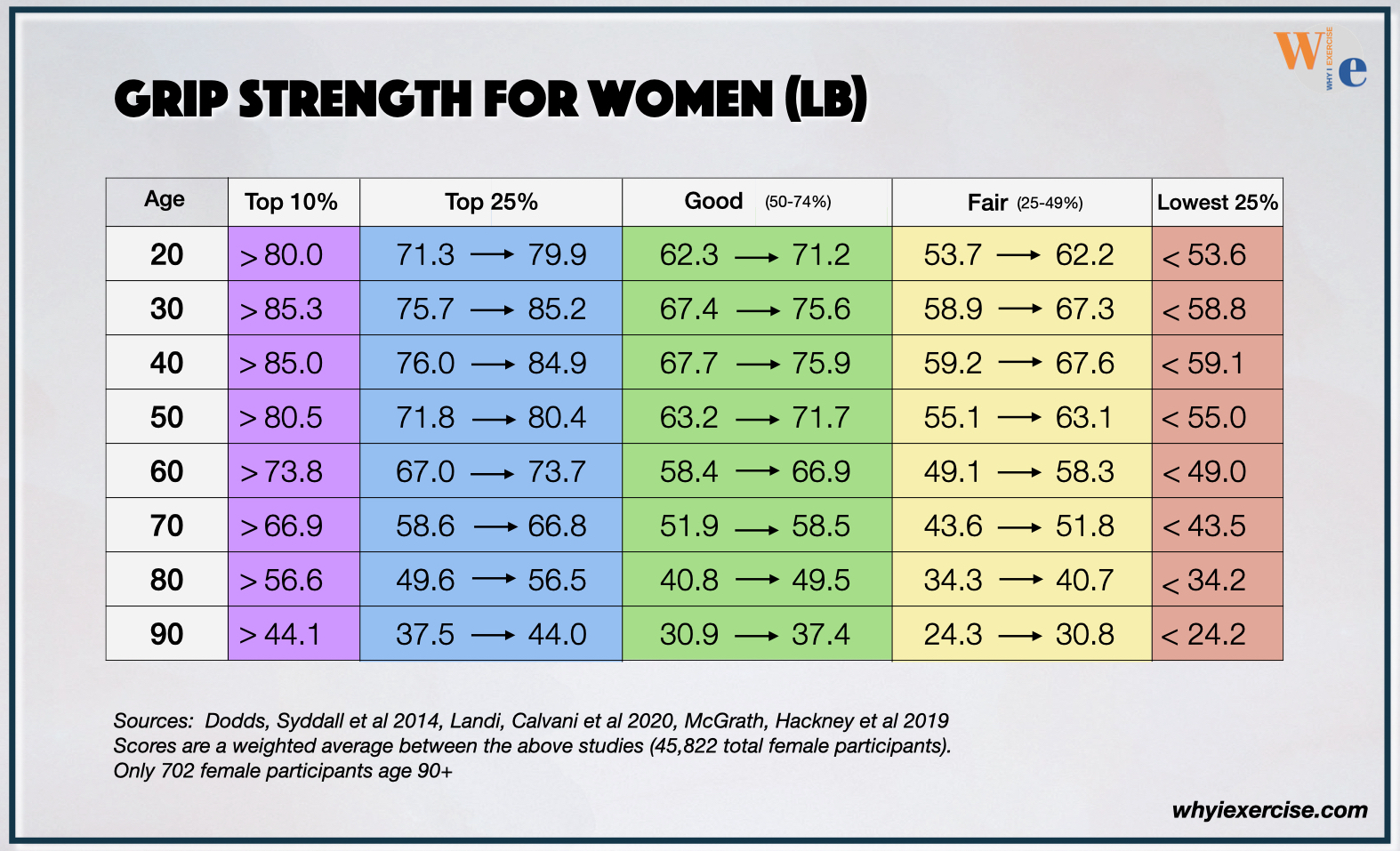 Age-group grip strength ratings for women in pounds.
Age-group grip strength ratings for women in pounds.How do you think you’d score compared to your peers? Women’s grip strength charts are above the men’s charts.
Scores are in pounds and kilograms. Find your age on the left of a chart and scan to the right for your score.
The average measured grip strength from studies of US and European female populations is about 29 kg or 64 lb. Women with near-average grip strength had a 30% lower death risk than those at 25 kg, according to a 2019 Univ. of Michigan study.
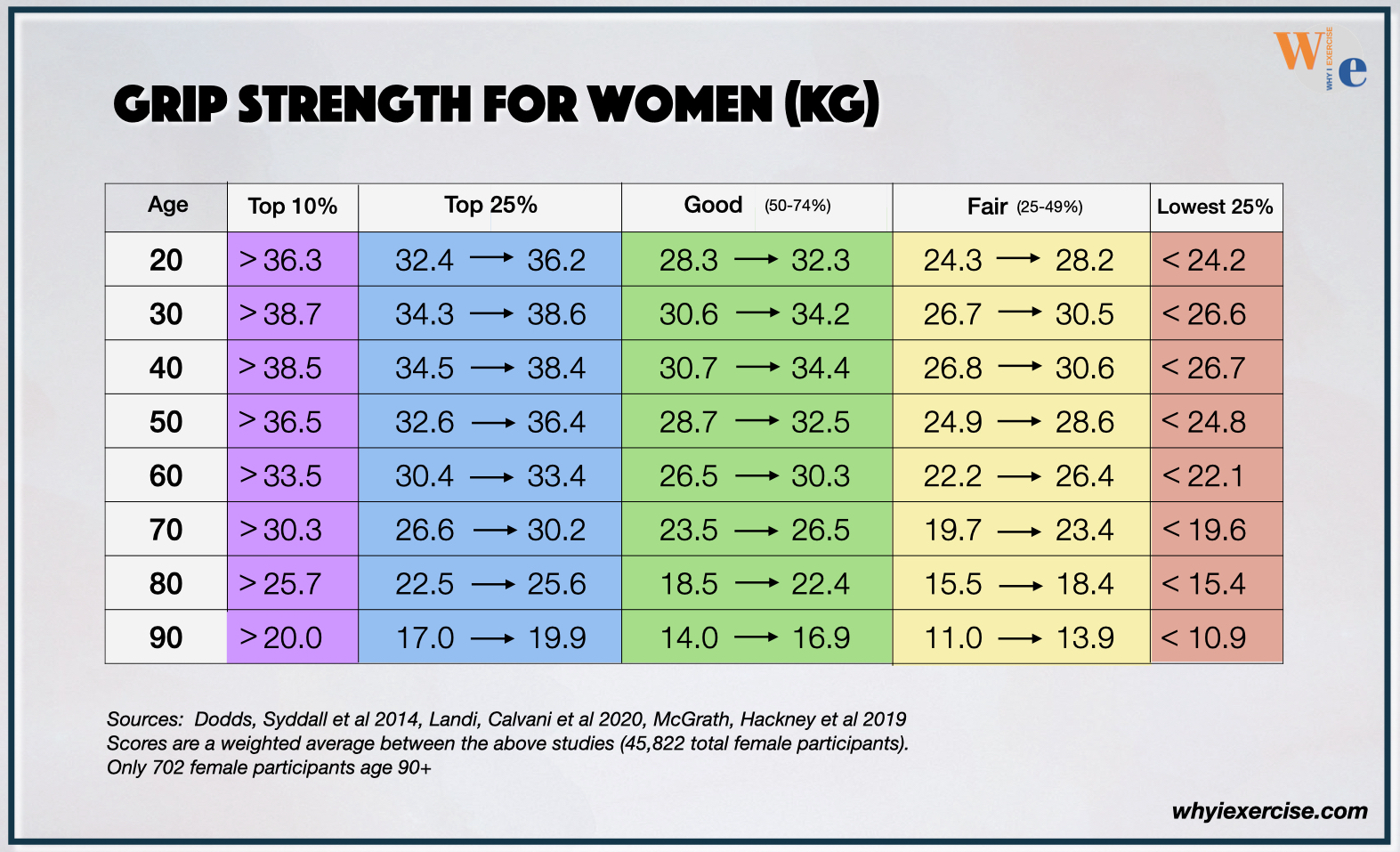
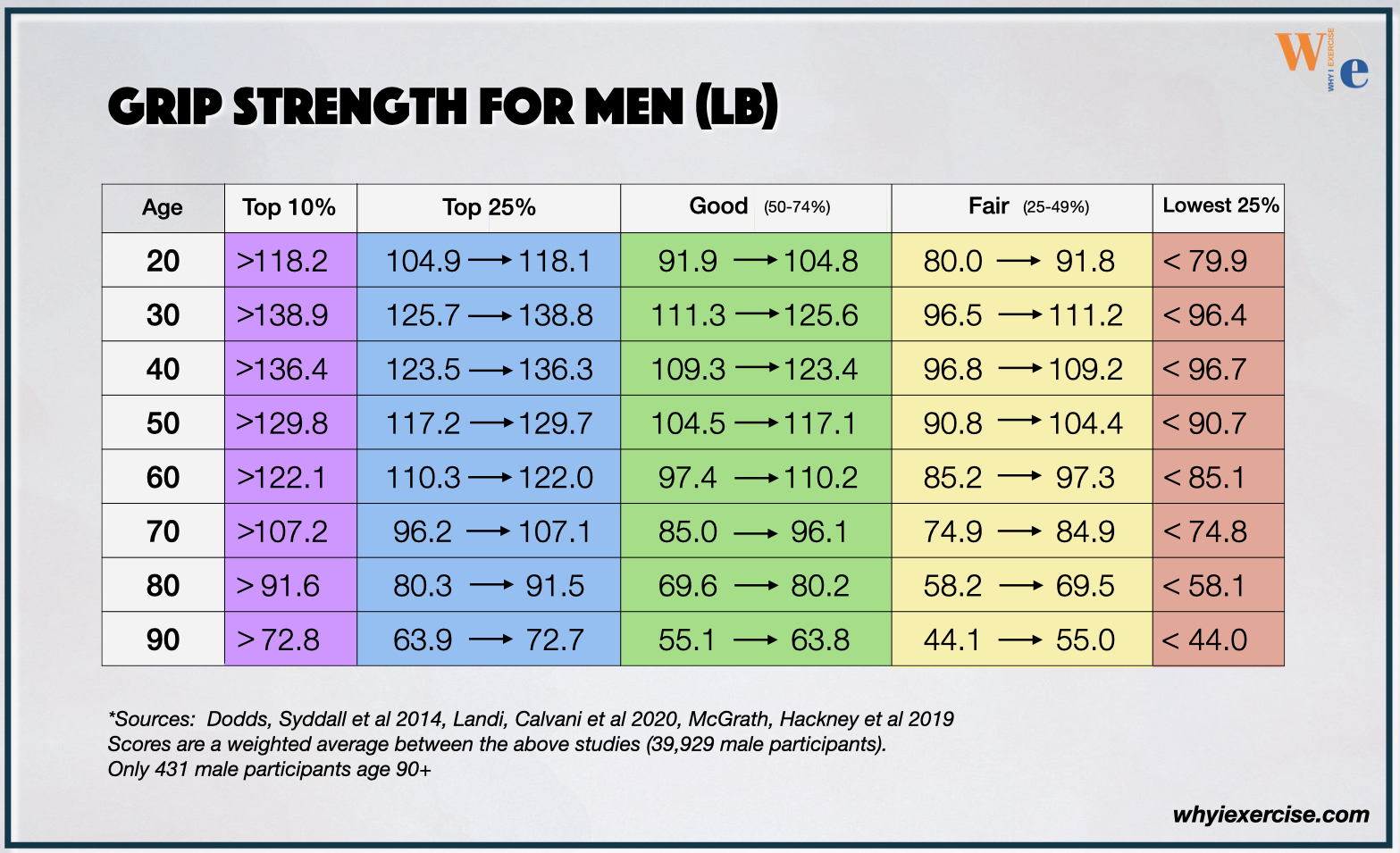 Age-group grip strength ratings for men in pounds.
Age-group grip strength ratings for men in pounds.The scoring standards are from a weighted average between US, UK, and Italian studies. It’s a good sample size of over 85,000 participants, though there were only 1100 participants aged 90 and above (8, 9, 11).
The average measured male grip strength from studies of US and European populations is 47 kg or 104 lb. Men with near-average grip strength had a 30% lower death risk than those at 42 kg or lower, according to a 2019 Univ. of Michigan study (8).
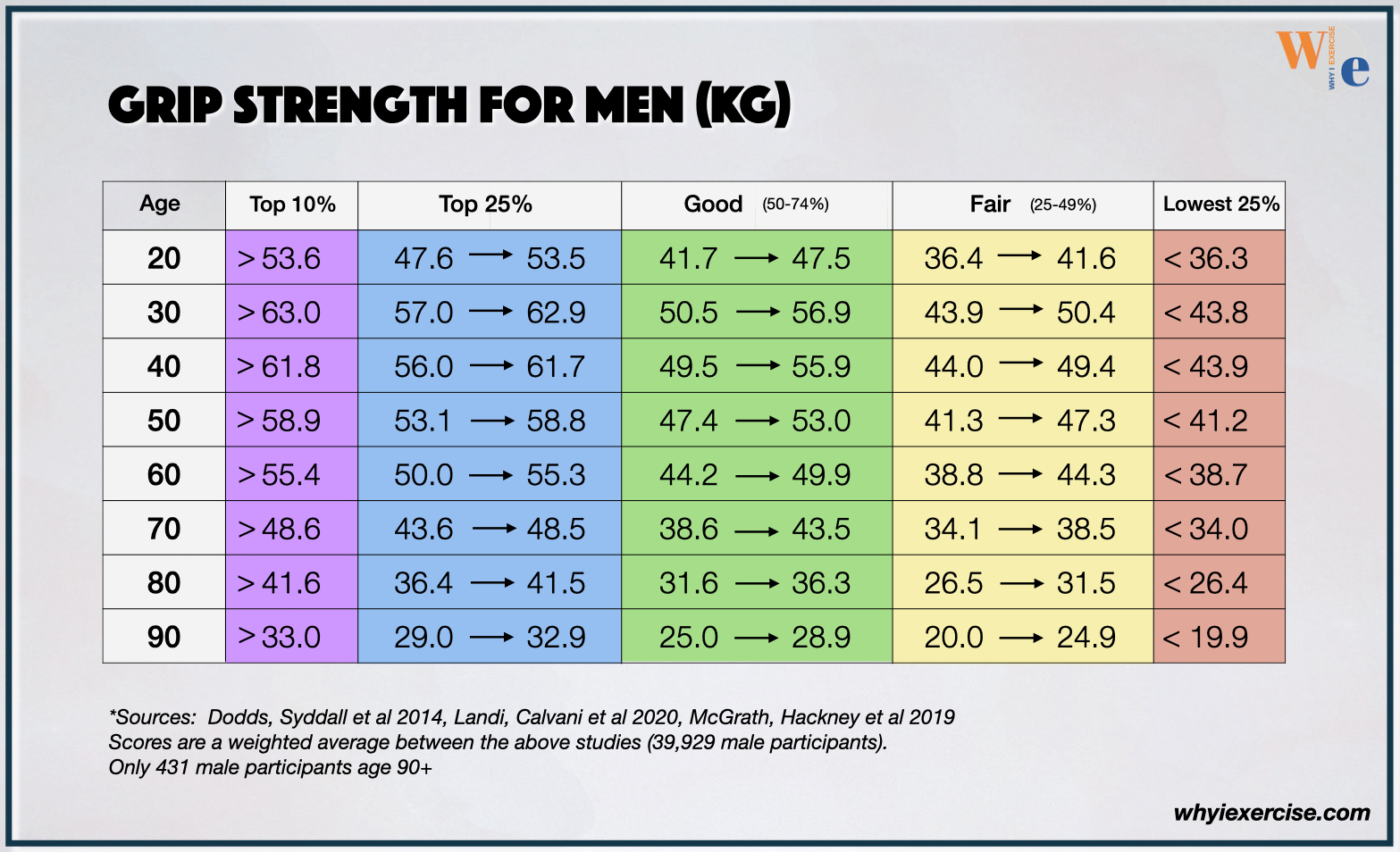
How to test your grip strength with a dynamometer
To watch a demonstration of the test, click on the masterclass video below, from Why I Exercise.
You can test your grip strength using a $30 grip dynamometer, which will give you reasonably reliable results.
To fit the device to your hand size, check that the base is resting on the heel of your hand with the handle in the middle of your four fingers.
Prepare your muscles for the test as needed with a warm up including a brisk walk or light calisthenics exercises, range of motion for your fingers, and wrist and hand stretching.
To take the test, sit down and hold the dynamometer with your elbow bent 90 degrees and your palm turned inward so that your thumb is pointing up. Hold still and squeeze with your maximum effort. Take a 2 to 3 minute rest break and repeat. One more 2-3 minute rest break and squeeze again. The best of three attempts with your dominant hand is your score (17).
You may get a higher score by standing and straightening your arm, but in our reference studies, participants were tested in the seated position with their elbow bent 90 degrees.
Exercise to Improve your grip strength
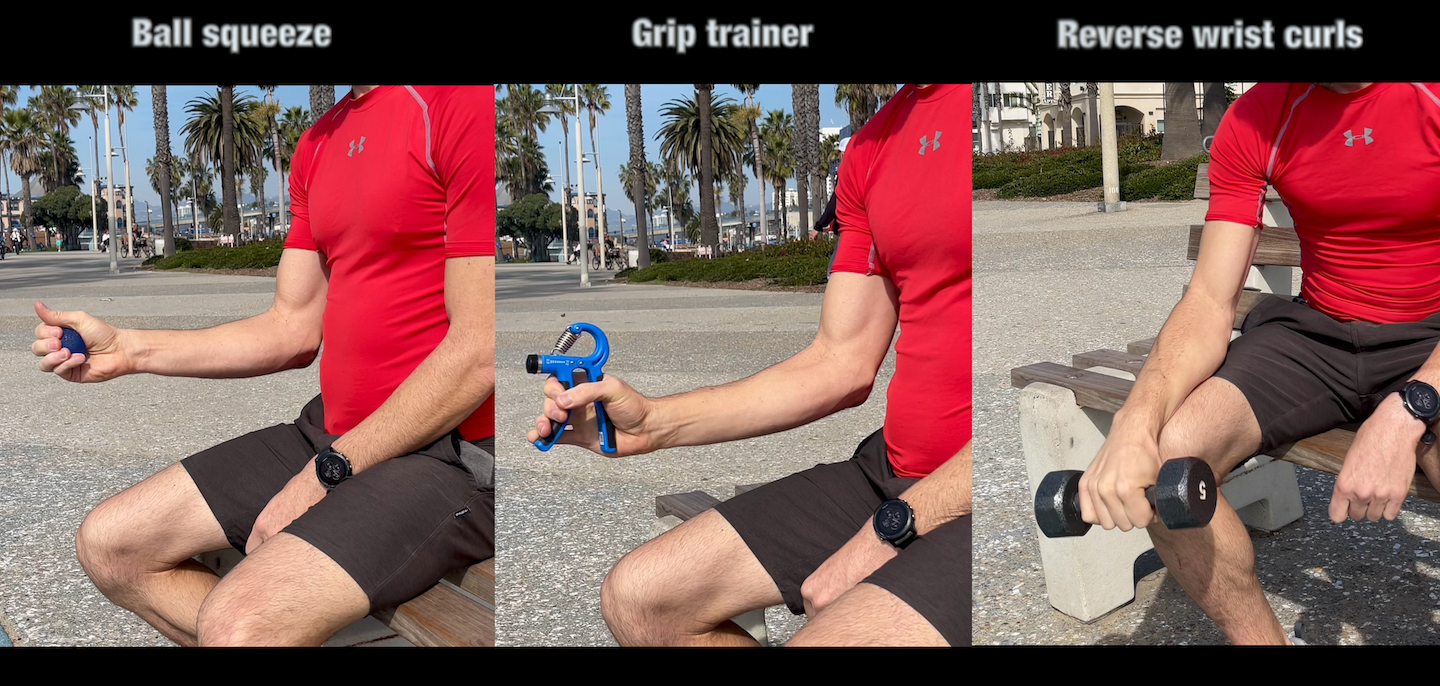 Target weak wrist and hand muscles with these exercises.
Target weak wrist and hand muscles with these exercises.Isolation grip strengthening exercises such as towel twisting or wringing, ball gripping, reverse wrist curls, and grip trainer exercises serve well for beginners or as supplemental exercise, especially if your grip is relatively weak compared to your other upper body muscles.
For the most part, optimal grip strength training incorporates exercises that help develop the strength of your entire upper body.
Using minimal equipment, pull-ups, chin-ups, hanging from a bar (muscles engaged), and rowing pull-ups will all train your grip strength. These exercises also train your biceps, shoulder, core, and scapular muscles to varying degrees.
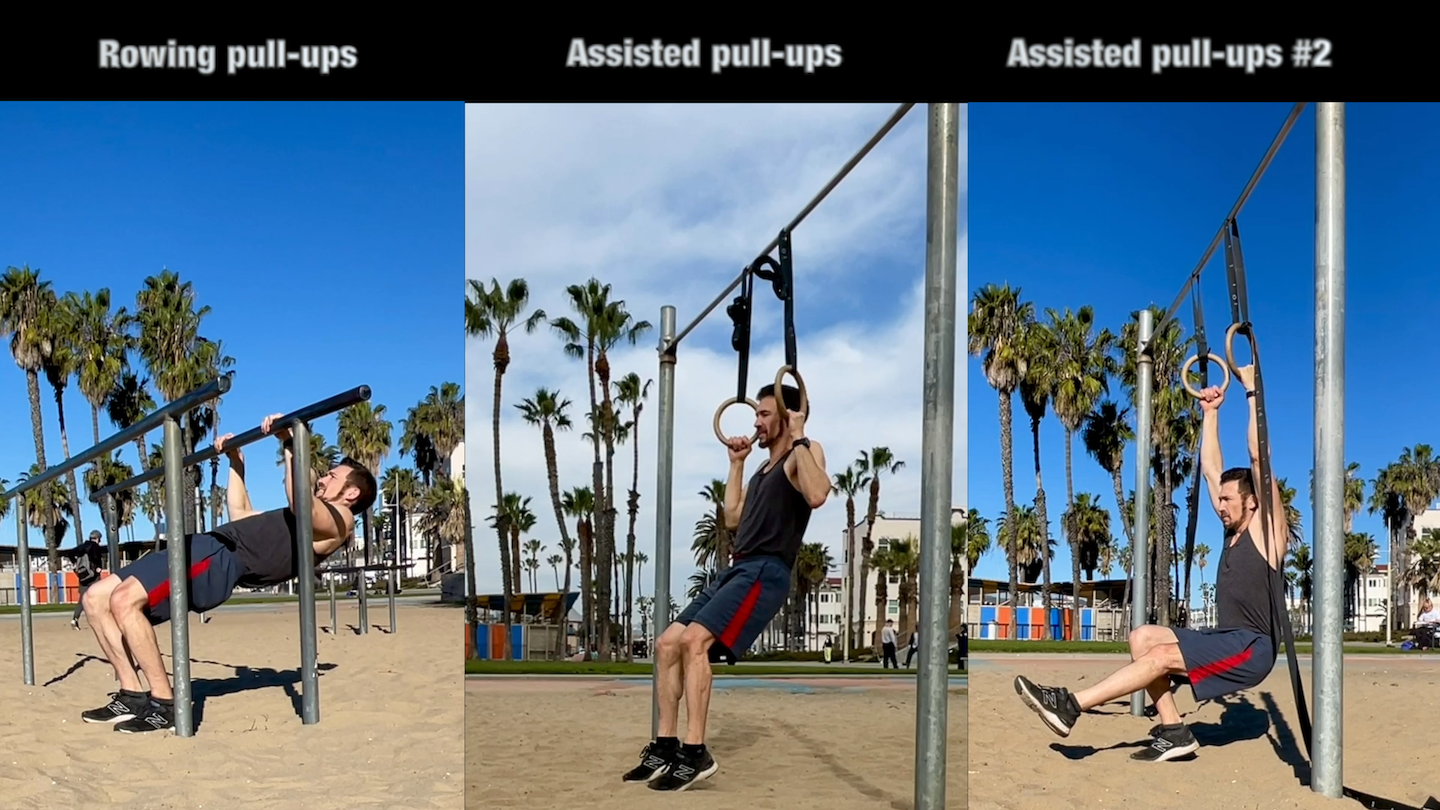 Strengthen your grip and your arms, back and shoulders with minimal equipment.
Strengthen your grip and your arms, back and shoulders with minimal equipment.As alternative options, weight training, carrying or lifting heavy objects (be safe!), climbing a rope, and rock climbing are effective methods to develop your grip strength.
Grip strength relative to BMI and body weight
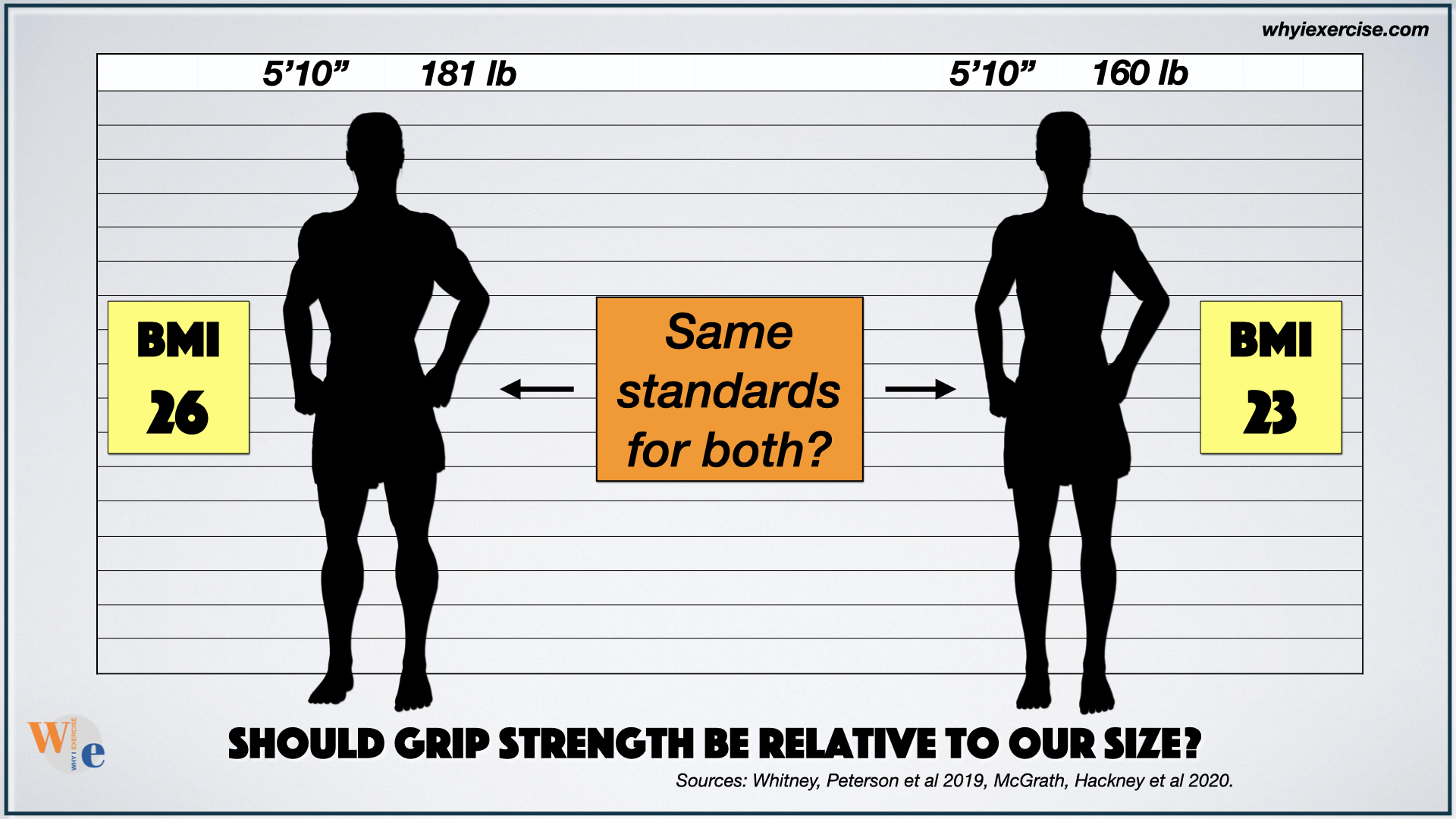 Should large people have the same health standards for grip strength as their smaller peers?
Should large people have the same health standards for grip strength as their smaller peers?If your score was lower than you hoped, you might wonder how body size might affect your score. Some studies have observed that optimal grip strength standards may vary based on body size and have developed standards for grip strength relative to BMI (13, 14).
To get your score, divide your grip strength in kilograms by your body mass index. The average 50-year-old woman in the US has a grip strength of 30.7 kg and a 29.8 BMI. Dividing 30.7 by 29.8 gives her a score of 1.03.
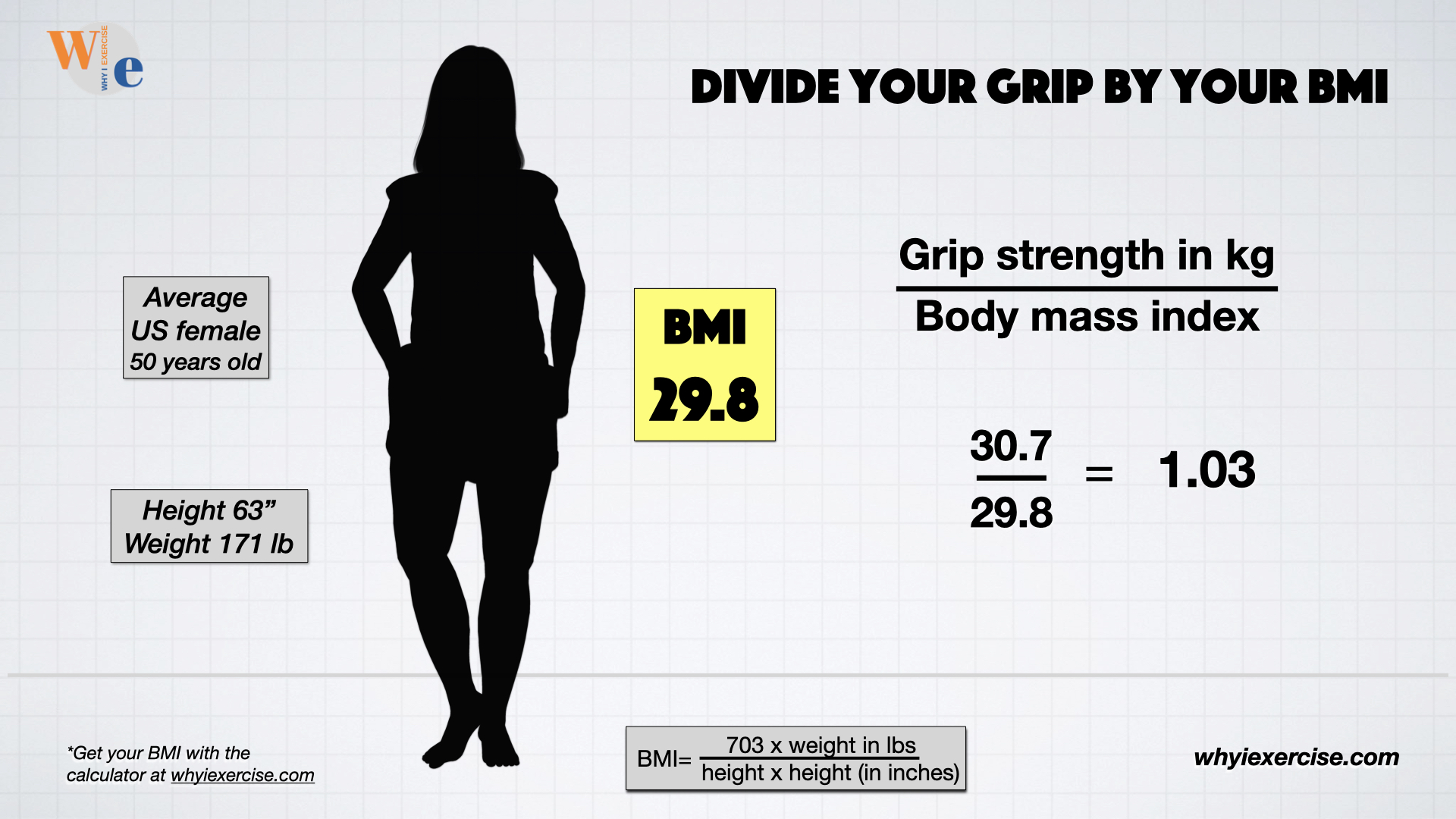 Divide your grip strength by your BMI and compare your score to your peers.
Divide your grip strength by your BMI and compare your score to your peers.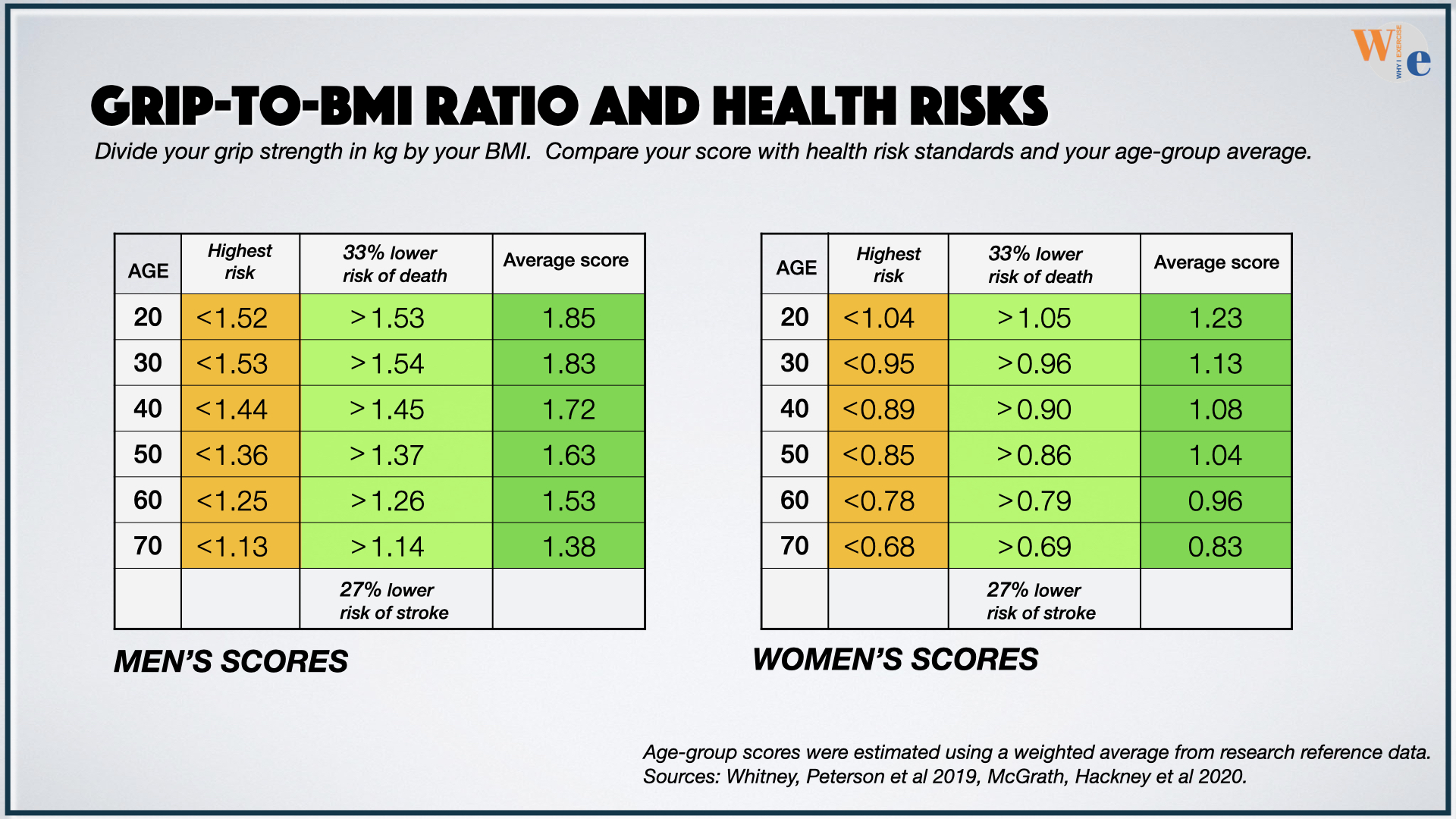 Compare your score to your age group average and standards for lower risks of death and stroke on this chart.
Compare your score to your age group average and standards for lower risks of death and stroke on this chart.Find your score by dividing your grip strength score in kg by your BMI.
While there is not as much health-related data for grip relative to BMI, this data can provide context to help you understand your strength level and decide whether you need to increase your training.
How do your scores compare for Grip-to-BMI vs grip strength alone? As another point of reference, a University of Michigan study found the average grip strength/body weight is about 0.55-0.60 for men and 0.40-0.45 for women (14). Divide your grip strength score by your body weight to compare your score.
Grip strength and blood pressure
While grip strength is known to be associated with improved cardiovascular health in general, there have been mixed reviews when it comes to blood pressure. A 2023 study in the Journal of Human Hypertension may have cleared up the matter.
Scientists found a higher risk of increased blood pressure with increased grip strength, but this occurred mostly in people who were overweight or obese, or in those who had a high body fat percentage (18).
Conclusion
Grip strength is an easy-to-test physical attribute that gives you meaningful insights into the impact of your upper body strength on your long-term health and well-being. Test, train, and retest to check your progress.
Every kilogram or pound of improvement can make a difference! Grip strength accurately represents your overall strength and well-being when all your upper body muscles are well-trained, so train your grip as part of a well-rounded strengthening program.
To learn more about fitness, aging, and the potential effects of body weight on your health, see the masterclass articles below.
More Masterclass articles
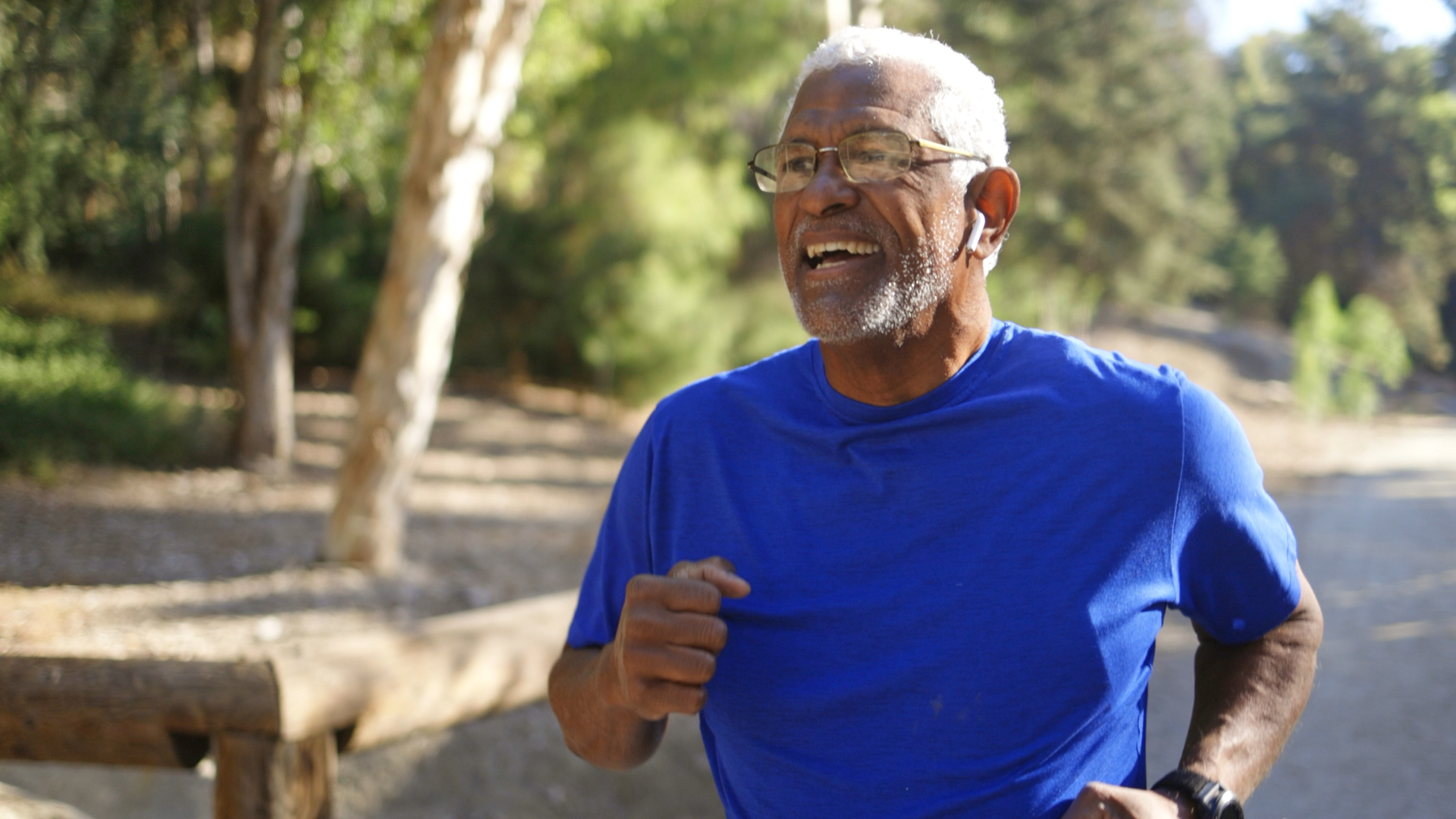
Have we been aging too quickly?
Exercise and inactivity impact the ways our bodies age. With this in mind, how could (or should) we be aging? You’ll see in-depth, research-based scientific analysis of the aging process, plus inspiring examples of healthy aging.
Age 74 and athletic? Amazing gymnast shares his secrets! (Video)
At age 74, Kim Goodwin is (in many ways) stronger and more athletic than most young adults. He can do over 20 pull-ups, climb a 25-foot rope and perform acrobatic maneuvers on gymnastics rings, among other abilities! In this video, Kim shows us his skills and shares his story—how he continued getting stronger over so many years!
Body mass index (BMI)--Uncovering the truth behind your weight and health.
Learning the health advantages of different sizes and weight groups can help you zero in on what you want for yourself. Take a step toward optimal health with weight goals you can commit to achieving.
references
1) López-Bueno R, Andersen LL, Koyanagi A, Núñez-Cortés R, Calatayud J, Casaña J, Del Pozo Cruz B. Thresholds of handgrip strength for all-cause, cancer, and cardiovascular mortality: A systematic review with dose-response meta-analysis. Ageing Res Rev. 2022 Dec;82:101778. doi: 10.1016/j.arr.2022.101778. Epub 2022 Nov 1. PMID: 36332759.
2) López-Bueno R, Andersen LL, Calatayud J, Casaña J, Grabovac I, Oberndorfer M, Del Pozo Cruz B. Associations of handgrip strength with all-cause and cancer mortality in older adults: a prospective cohort study in 28 countries. Age Ageing. 2022 May 1;51(5):afac117. doi: 10.1093/ageing/afac117. PMID: 35639798; PMCID: PMC9351371.
3) Bohannon RW. Muscle strength: clinical and prognostic value of hand-grip dynamometry. Curr Opin Clin Nutr Metab Care. 2015 Sep;18(5):465-70. doi: 10.1097/MCO.0000000000000202. PMID: 26147527.
4) Wearing, J., Konings, P., Stokes, M. et al. Handgrip strength in old and oldest old Swiss adults – a cross-sectional study. BMC Geriatr 18, 266 (2018). https://doi.org/10.1186/s12877-018-0959-0
5) Celis-Morales C A, Welsh P, Lyall D M, Steell L, Petermann F, Anderson J et al. Associations of grip strength with cardiovascular, respiratory, and cancer outcomes and all cause mortality: prospective cohort study of half a million UK Biobank participants BMJ 2018; 361 :k1651 doi:10.1136/bmj.k1651
6) Rantanen T, Guralnik JM, Foley D, Masaki K, Leveille S, Curb JD, White L. Midlife hand grip strength as a predictor of old age disability. JAMA. 1999 Feb 10;281(6):558-60. doi: 10.1001/jama.281.6.558. PMID: 10022113.
7) Chun SW, Kim W, Choi KH. Comparison between grip strength and grip strength divided by body weight in their relationship with metabolic syndrome and quality of life in the elderly. PLoS One. 2019 Sep 6;14(9):e0222040. doi: 10.1371/journal.pone.0222040. PMID: 31490975; PMCID: PMC6730916.
8) Whitney DG, Peterson MD. The Association Between Differing Grip Strength Measures and Mortality and Cerebrovascular Event in Older Adults: National Health and Aging Trends Study. Front Physiol. 2019 Jan 7;9:1871. doi: 10.3389/fphys.2018.01871. PMID: 30666214; PMCID: PMC6330303.
9) Dodds RM, Kuh D, et al, Can measures of physical performance in mid-life improve the clinical prediction of disability in early old age? Findings from a British birth cohort study. Exp Gerontol. 2018 Sep;110:118-124. doi: 10.1016/j.exger.2018.06.001. Epub 2018 Jun 7. PMID: 29885357.
10) Peterson MD, Collins S, Meier HCS, Brahmsteadt A, Faul JD. Grip strength is inversely associated with DNA methylation age acceleration. J Cachexia Sarcopenia Muscle. 2023 Feb;14(1):108-115. doi: 10.1002/jcsm.13110. Epub 2022 Nov 9. PMID: 36353822; PMCID: PMC9891916.
11) Dodds RM, Syddall HE, Cooper R, Benzeval M, Deary IJ, et al. (2014) Grip Strength across the Life Course: Normative Data from Twelve British Studies. PLoS ONE 9(12): e113637.doi:10.1371/journal.pone.0113637
12) Landi F, Calvani R, Martone AM, Salini S, Zazzara MB, Candeloro M, Coelho-Junior HJ, Tosato M, Picca A, Marzetti E. Normative values of muscle strength across ages in a 'real world' population: results from the longevity check-up 7+ project. J Cachexia Sarcopenia Muscle. 2020 Dec;11(6):1562-1569. doi: 10.1002/jcsm.12610. Epub 2020 Nov 4. PMID: 33147374; PMCID: PMC7749608.
13) McGrath R, Hackney KJ, Ratamess NA, Vincent BM, Clark BC, Kraemer WJ. Absolute and Body Mass Index Normalized Handgrip Strength Percentiles by Gender, Ethnicity, and Hand Dominance in Americans. Adv Geriatr Med Res. 2020;2(1):e200005. doi: 10.20900/agmr20200005. Epub 2019 Dec 31. PMID: 31930203; PMCID: PMC6954001.
14) Peterson MD, Krishnan C. Growth Charts for Muscular Strength Capacity With Quantile Regression. Am J Prev Med. 2015 Dec;49(6):935-8. doi: 10.1016/j.amepre.2015.05.013. Epub 2015 Jul 29. PMID: 26232900; PMCID: PMC4656076.
15) López-Bueno R, Calatayud J, Andersen LL, Casaña J, Koyanagi A, Del Pozo Cruz B, Smith L. Dose-response association of handgrip strength and risk of depression: a longitudinal study of 115 601 older adults from 24 countries. Br J Psychiatry. 2023 Mar;222(3):135-142. doi: 10.1192/bjp.2022.178. PMID: 36464972; PMCID: PMC9929711.
16) Wang CY, Chen LY. Grip strength in older adults: test-retest reliability and cutoff for subjective weakness of using the hands in heavy tasks. Arch Phys Med Rehabil. 2010 Nov;91(11):1747-51. doi: 10.1016/j.apmr.2010.07.225. PMID: 21044721.
17) Kwak, Doo-Hwan & Lee, Kyung-Sun & Kwag, Jong-Seon & Jung, Myung-Chul & Kong, Yong-Ku. (2011). Investigation of the Effects of Resting Time and Trial on the Maximal Grip Strength. Journal of the Ergonomics Society of Korea. 30. 10.5143/JESK.2011.30.3.381.
18) Pratt J, Paolocci N, Boreham C, De Vito G. Grip strength positively correlates with blood pressure in individuals with abnormal adiposity. J Hum Hypertens. 2024 Feb;38(2):110-119. doi: 10.1038/s41371-023-00862-6. Epub 2023 Sep 9. PMID: 37689823; PMCID: PMC10844084.
